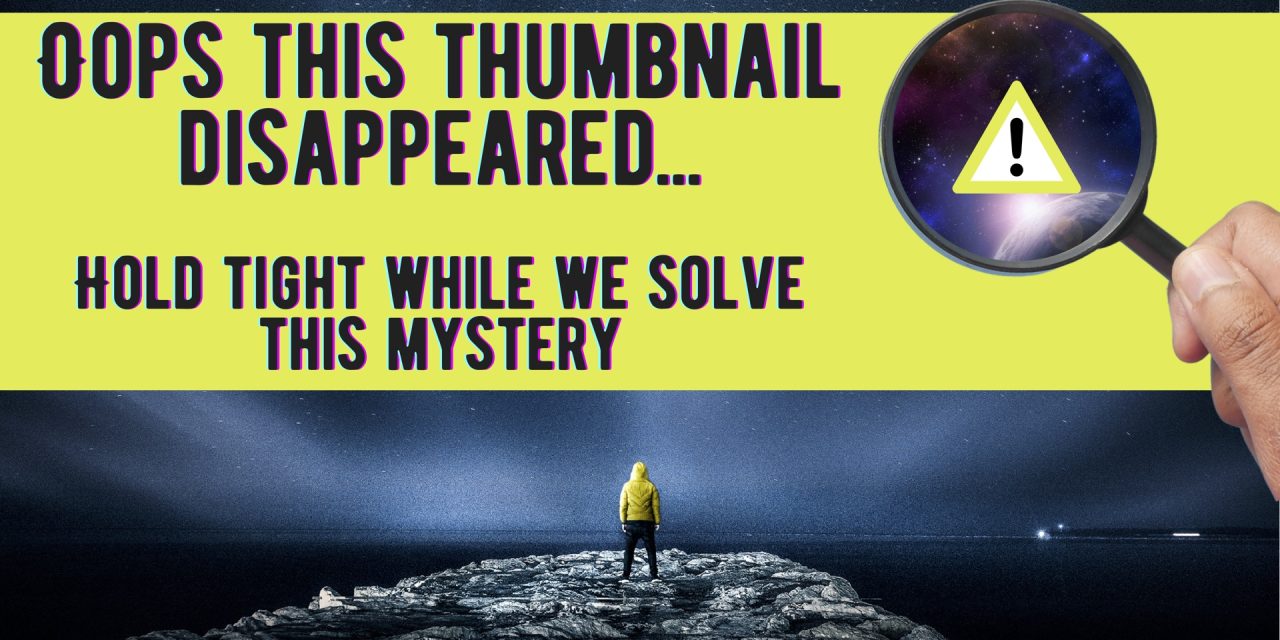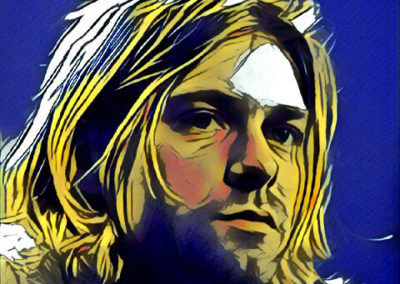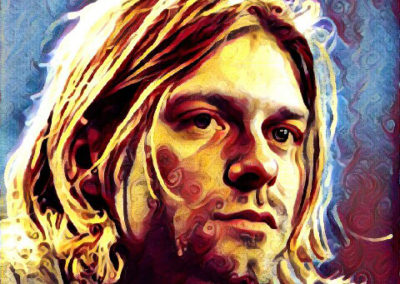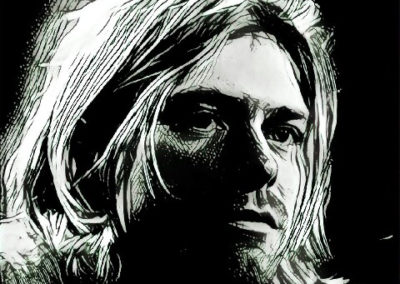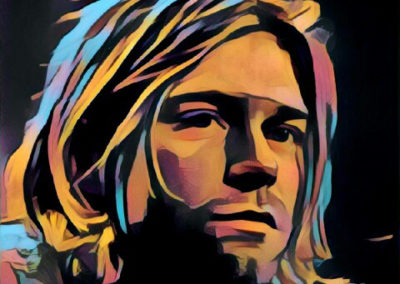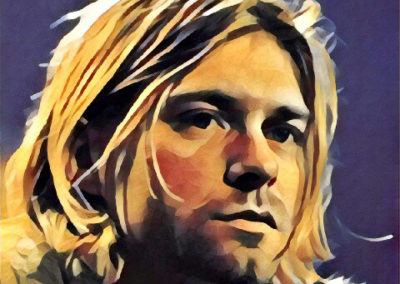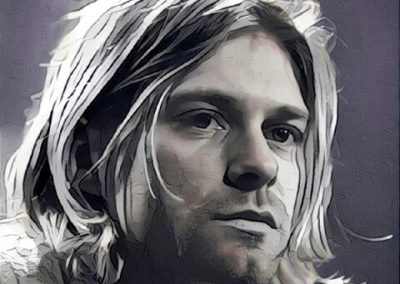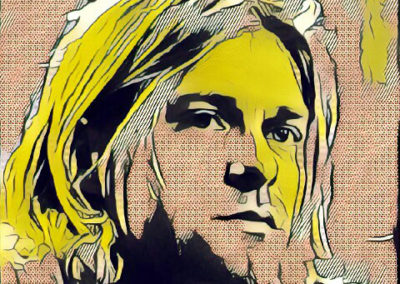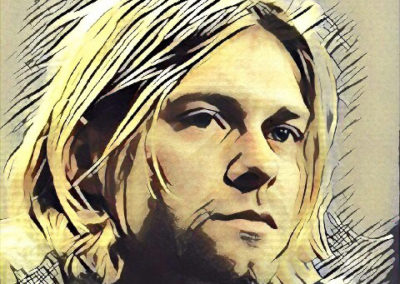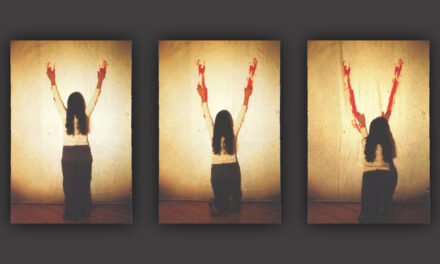Kurt Cobain
For the lovers of Nirvana, for a musical generation, Kurt Cobain’s death in April of 1994 was the same sort of blow to the psyche that the murder of a vibrant President had been for earlier generations in 1963. Not long out of a drug rehabilitation facility, Cobain had died of an overwhelming heroin overdose and a self-inflicted gunshot wound, all at the same time, said the Seattle police.
There was anguish, disbelief, and over time the tragedy of “copycat suicides” emerged. If this was Kurt Cobain’s way out of a painful world, then perhaps….
But almost immediately a countervailing theory emerged. How could someone with an ultra-lethal level of heroin in their system even hold and fire a shotgun, and why would they depart that way, rather than float off gently on an opiate? Why did the fingerprint evidence not add up, why did the “suicide note” found at the scene seem so odd? Tom Grant, a private investigator hired by Kurt’s wife, Courtney Love, came to believe that Kurt’s “suicide” was staged, and the more he learned, the worse the situation smelled. The police had made the classic mistake, he believed, of assuming a suicide based on rumor or demographics–one more rock star with a drug problem has killed himself. But the hundreds of millions of dollars–in current and future earnings–of Cobain’s estate provided adequate motive for murder.
The former Chief of Police of Seattle regrets the rush to judgement of 1994, saying it all should have been done differently. We may never see a case, a prosecution, develop after all these years. But in fact, the case for suicide does appear sketchy, much evidence suggests foul play, and the whole affair deserves sober analysis.
Just what happened, in the bleak rain of April in Seattle, to a generation’s icon, Kurt Cobain?
THE GREAT QUESTION
Some experts on murder and suicide cases have commented: setting up a murder of a troubled individual, staged to look like suicide, happens more than we might think. Want to kill a junkie? Just do a fairly careful job of staging after you bump them off, make sure not to leave any really obvious signs of foul play, and your chances are good.
The cops will find them and their drug paraphernalia, hear about their history, and not investigate with too much vigor. It’s pretty obvious what happened, the detectives will agree. One more junkie overdid it, and ended his life, maybe by accident, maybe as a suicide, who knows? Who really cares? Another junkie bites the dust.
Kurt Cobain’s death was no accident. He was found dead not only from a quite severe heroin overdose, but also a shotgun blast right to the head, from the shotgun he was found holding. A guy really, really determined to die, right?
Except the more you look at the case, and ask logical questions, the less sense it makes. Why would Kurt not just sail off pleasantly on his overdose, ‘enough heroine to kill a horse?’ Why a shotgun blast to his own head on top of that? Could he have even held the gun and pulled the trigger, fading that fast from that much dope—there’s apparently no precedent for anyone managing that.
A crime scene photo, his paraphernalia.
Even if the ID was pulled out by a detective, do these pictures look just a little too perfect, too suggestive, that is, staged?
Who would have the motivation to do what exactly in relation to Mr. Cobain—the police, relying on true and tried principles, look at money as the huge motivator…
Twenty years ago Saturday, as best the coroner could tell, Nirvana front man Kurt Cobain ended his life with a shotgun at his Seattle home. An electrician found the 27-year-old’s body three days later.Rock stars who die at the height of their fame, however, never truly recede from either the public consciousness or corporate coffers. And despite his anti-hero, anti-corporate persona, the iconic Cobain is not the exception.
Nirvana, the band Cobain formed in Aberdeen, Wash., in the late 1980s, sold 350,000 albums in 2013 as well as 900,000 singles, according to Dave Bakula, senior vice president for industry insights at Nielsen.
With an average price of $10 per album and $1 per single, Nirvana’s music sales last year would translate into revenue of $4.4 million.
CNBC
April 5, 2014
What the article doesn’t make clear are the most accepted overall estimates of Cobain estate, often around a whopping $450 million, nearly half a billion dollars. From time to time that figure is revised upward, as music sales continue.
Cobain died intestate: no will. He was reportedly trying to fix that, and exclude Courtney’s Love’s influence to the extent possible, at the time of his death.
A Will would have named an executor who could exercise control over his estate, however the laws of intestacy meant that Cobain’s widow, Courtney Love, with a well documented history of mental health problems and well publicized struggles with addiction, gained the right to manage his estate including rights to his image, publishing and licensing rights, and performance royalties.It has been reported that Cobain contacted a lawyer before he died to draft a Will excluding Love as he was contemplating divorcing her, as a Will wasn’t drafted the distribution and management of his estate was exposed to difficulties.
Heirsandsuccesses
October 22, 2015
Plenty of money on the table to fight about, but does that mean anything, was the heavy heroin user just ready to go too far one day?
Is there any evidence that Cobain’s death, of which his wife was the prime financial benefactor, was other than a suicide? Opinions differ.
As noted in the documentary “Soaked in Bleach,” based on the accidental odyssey of private investigator Tom Grant into Cobain’s disappearance and death, Norm Stamper, Chief of Police in Seattle at the time says that the inquiry deserves a do-over. He’s not sure the initial investigation got it right.
Yes opinions differ, with a strong ‘He Was Murdered’ camp and a vocal ‘Don’t Pay Attention to Silly Conspiracy Theories’ camp.
Noted documentarian Nick Broomfield seems dismissive of what he labels “conspiracy theories” in his interesting work “Kurt and Courtney.” A fascinating film, but hard to draw conclusions from, as his camera follows lots of miscellany here and there, with little overall structure. It does evoke a powerful portrait of Courtney Love, a stark and chilling one at that.
This Mystery like so many revolves around big If’s. If, if, if Courtney was truly experimenting with her printing style (printing letters as handwriting) around the same time that Kurt’s “suicide note” was discovered (the practice document survives and can be viewed), as affirmed in the Tom Grant-based documentary, if she truly was making numerous inconsistent statements to investigators, all of that looks far from innocent. If, if she had offered El Duche $50,000 to kill Kurt weeks before in a fit of rage, as he alleged, that’s also significant. (He talked freely about that for a time, then died in an….accident when hit by a train in a remote part of LA. Potential mysteries within mysteries.)
Mystery Analysts are strongly advised to watch “Soaked in Bleach” (which concludes murder) and “Kurt and Courtney” (which concludes suicide) and read, as a starting point, “Love and Death: The Murder of Kurt Cobain,” by Wallace and Halperin, and then balance that out with other books and blogs as you discover them. Theories will be all over the place.
Love and Death: The Murder of Kurt Cobain
The Big Question is based on If’s, and the logical conclusions to be drawn from the facts, or lack thereof.
IF Kurt was truly suicidal, and coming off a failed experience at rehab, at an especially troubled, even tortured time in his life with his marriage dissolving and his career only grinding him down, that makes a self-inflicted death that much more likely. IF Courtney was capable of explosive violence, was aware he planned to divorce her and shield most of the money from her, and had tried to find a contract killer for Kurt, that gives the murder hypothesis significant credibility. IF Courtney’s frantic search for Kurt in early April, 1994 was genuine and the local authorities used reasonable diligence in their investigation, murder is unlikely and suicide a logical finding. IF Tom Grant the investigator is fully honest, credible, and level-headed, his litany of evidence that suicide was forensically unlikely, and that Courtney was playing elaborate games throughout the crucial period, speaks volumes about a strong possibility of foul play.
You, the analyst, must answer some of the IF questions, and it will lead you to your best conclusion.
POINT, AND COUNTERPOINT
Don’t let Kurt’s engaging ways fool you, one point of view goes, he was really a miserable soul his whole life, always close to sinking down the hole of depression. Look at how he masked his supposedly wretched physical pain–a bad stomach, he claimed–and presumably emotional pain as well, with opiates in vast, wholesale quantity. His intimates even did an “intervention,” got him into a formal rehab program briefly before his death, from which he literally escaped by going over the wall and flying back home to Seattle. Forget about whether you think the “suicide note” is iffy, wasn’t his whole damned life a suicide note? The incident in Rome, where timely medical intervention saved him from massive overdoses of dope. How much more of a poster boy could he have been, a poster boy for a tormented rock star destined to burn out his own lights at age 27, the age when so many of them cash it in. How much more classic a rock-star suicide could you want?
OK, that narrative sounds great to nail home the suicide theory, but it hardly tells the whole story, even an accurate story. Yes, the guy was in terrible physical pain much of his young adult life, and a mis-diagnosed stomach ailment was the cause. Once the doctors finally got it right he had a new lease on life, liberated from constant pain. Heroin use continued, but that’s not really something you can stop overnight just because physical pain has been medically treated. Meanwhile he was making changes in his life, positive for him if not for Courtney Love. He planned to divorce her, ignoring myriad calls as she tried to reach him at the rehab clinic in LA. Significantly, he’d asked his attorney to draft a will excluding her from the money of his emerging rock-music empire. His behavior in the days before his death shouldn’t be interpreted as suicidal but rather Kurt re-asserting Kurt, becoming his own man again without being sucked back into the Courtney vortex. Ask his best friends, such as Dylan Carlson, and they’ll tell you they sensed no suicidal tendencies in Kurt those days of March and April, 1994. Something else happened to the man whose body was found above the garage.
No, people love their “conspiracy theories,” and in this case it helps them believe that their hero didn’t take the easy way out. But look at the facts, Kurt’s life in turmoil, a suicide note, and most of all an assessment of the death scene by professionals from a big-city police department. The Seattle PD called it a suicide in April of 1994 and they’ve never wavered. And for God’s sake, who in Seattle had it in for Kurt, who would have gone to all that trouble? Murders are supposedly committed by those with motive, means, and opportunity. Yes, many point the finger at Courtney, they say a lot of money is a lot motive. She was in Los Angeles during those critical days, for crying out loud. Talk about a solid alibi. That’s why means and opportunity are the other parts of the classic trifecta. Let’s get real, even if she wanted to get rid of someone, even if she had a clue of how to do that, her arms don’t reach a thousand miles.
It’s you guys, who can’t imagine anything except an odd-ball suicide, who need to get real. The Seattle police are made up of fallible human detectives. Their own chief concedes that the investigation was flawed and should be done over again. The suicide note? The one with very different handwriting–large printing– toward the end, when, just by coincidence, Courtney was known to be experimenting with hand-printing styles right at that juncture? That suicide note? And Courtney suddenly needed to stay in LA for “business reasons,” although she didn’t really have any, during those critical days. She declares her husband suicidal, she’s desperate to find him, but doesn’t go to Seattle herself? Instead she contracts a private investigator–out of the phone book–to make a big show of searching for him, a PI who soon feels he’s being used as an actor in a very bad play. All this from a young woman who once bragged, yes boasted, that her social worker judged her a rare specimen of deceit, sheer cunning, and sociopath tendencies. She had Kurt’s body cremated quickly, and the death weapon melted down. No investigation decades after the fact can ever recover the initial fumbles, and Courtney will never be charged with anything. But do you really consider all her odd behaviors in L.A. that April as a legitimate alibi? That’s a tall stack of coincidences.
To place your mind above this mystery, you’ll have to review the relevant books, documents, photos, and documentary films. God, the Devil, and best solution to Mysteries reside in the details. Not in the casual, ranting articles on the internet.
DEVELOPMENTS
Back in 2014, from mainstream Time magazine:
The images are blunt, as most crime-scene photos are. The police aren’t interested in artistry or lighting. They just want to remember exactly how things looked. In that way, the pictures themselves are highly unsentimental, but they still have the power to provoke.”
Time Magazine, 2014
This refers to a very, very limited release of new photographic evidence by the Seattle PD.
A further excerpt:
1. Kurt’s last smoke was an American Spirit menthol. There’s a box of them on the floor, and a fresh butt on the ground, which appears to have been recently stubbed out.
2. Kurt still wore floppy hunting hats. But this isn’t the one from the oft-seen photo shoot in which he’s wearing white sunglasses and a leopard-print jacket. The ear flaps are shorter, and the shearling lining carries through to the brim.
3. Kurt wanted people to know it was him. He left his wallet near his body. Police were likely the ones who half-slid his ID out of its slot.
4. Kurt still didn’t mind effeminate color. He had a pink lighter.
5. Kurt didn’t always wear cool sunglasses. While he made those bug-eyed white sunglasses famous, he was wearing regular old black shades at the end.
6. Kurt was a junkie. A multi-millionaire could have at least used some fresh towels, but he didn’t care. He kept his rig in a Tom Moore cigar box. The contents include everything you expect from watching Drugstore Cowboy or Requiem for a Dream: blacked-up spoon, Q-tips, fresh syringes, another lighter, cotton balls black with spent smack and what appear to be rolling papers.
Cigarettes and heroin, those were Kurt’s final pleasures — not his guitar or Frances Bean. But that’s to be expected, I suppose. Look at Phil Hoffman: He was just down the street from his family, but escape was all he cared about at that point, whether he meant to end everything or not.
Time Magazine, March 21, 2014
Not much meat on the bones of a post in the Entertainment/Music section by a GenX blogger. A working assumption that the death was a suicide, with almost no knowledge one way or the other to back that up. “His last smoke was an American Spirit menthol.” Does this really rise as the cream of what we need to know about a complex case, and complex moment in our cultural history? The blogger does go on to discuss missing Kurt, and the potential he surrendered. The legacy will always be deeply spiced with What Might Have Been.
Then came 2015, and a documentary that accuses, and divides. One reviewer commented that Soaked in Bleach was likely to reinforce the biases that people already had about Kurt’s death, although it’s also opened numerous discussions.
Early 2016, and the Seattle police “reviewed” the case. They called theories other than suicide “interesting,” and nothing more. You can make of that what you will.
So what will 2016, 2017, 2018 and beyond bring to the discussion?
Feel free to bring any truly Fresh and/or Significant information to our attention, and we’ll post it here. This section is ongoing, it will never be closed.
SELECT BOOKS AND STUDIES
An earlier book by the pair, Who Killed Kurt Cobain?, tackled the subject but the new book constitutes the update. As of this time we’ve not read the first work.
Heavier than Heaven: A Biography of Kurt Cobain, 2002, by Charles R. Cross, and several other works have attempted to wrap mind and soul around a complex young generation’s icon. As we study these works more deeply we will review them.
From Courtney Love, The Queen of Noise, in 1996, by Melissa Rossi, to Courtney Love: The Real Story, by Poppy Z Brite, 1997, Courtney’s story has long been available between two covers as well. Citizens reviewers of these and other works about the starlet perceive a dilemma. They note that if the author is no friend of Courtney, then the work attempts to master an enigma at arm’s length, but when the author is a Love associate, the writing tends to sound like the friendly puff of a publicist.
Soaked in Bleach, the documentary by Benjamin Statler released in 2015, has been amply discussed on this site. In our view, everyone interested in Cobain’s death should give the film a careful viewing, and then ponder their position. Everyone in the end will see these arguments through a different lens.
Montage of Heck, an HBO documentary on Cobain and Nirvana, (also from 2015) may give the whole issue texture. Some familiar with the grunge world, such as Buzz Osborne, maintain it was mostly nonsense, simply untrue.
SIGNAL AND NOISE
In 2016, a national columnist offered her thoughts on the Cobain question, including the following:
Two years ago, near the twentieth anniversary of Cobain’s death, the police announced they had “Seattle Police Department Cold Case Detective Mike Ciesynski review the case file in anticipation of media inquiries about Cobain’s death, and the many conspiracy theories surrounding the case.” Ciesynski immersed himself in the known information about the mysterious last days of Cobain, who was found dead of a gunshot in his home by an electrician. He watched documentaries and read articles about the conspiracy theories. And while he admitted, “They’re all very interesting,” he added decisively, “It’s a suicide. This is a closed case.”
May Elizabeth Williams, Salon, March 18, 2016
If you know little about the case, the short article excerpted above would leave an indelible impression: any backward-looking fuss over Cobain’s death owes to the primal urge to see conspiracy, dark works, evil complexity, and a back-story behind every fallen hero. But, there’s really nothing to see here, folks, except some cheap mystification, spawned by the kind of guy who lives in his grandmother’s basement and has nothing better to do.
As serious students of Cobain’s last days know well, that’s many miles off the mark. Even if you conclude at the end of the day that a suicide was most likely you must travel a path of legitimate, complex mystery to get there. Abundant scientific and circumstantial evidence, subtle and intriguing, are at play.
Why, then, would a bright woman, a talented, recognized writer who pens delightful articles and columns, leave us with something so misleading? Don’t be too quick to judge. In one sense, she’s right. The crazies come out, as if howling at the full moon, when something dramatic happens in the mists of the under-culture, where the imagination can run wild. And especially if a rock-star makes it to a twenty-seventh birthday, and no farther.
“It had to have been Courtney, man, I mean do you know how skanky that bitch was when……”
“People just have to listen to his lyrics, dude. He promised he was going out his own way, you know, I mean….”
“But who wouldn’t kill for half a billion dollars? You know I would, in a heartbeat.”
“When a guy jumps the wall to get out of rehab, it’s kind of like he’s ready to jump out of life, it’s obvious, don’t you get it?”
And those would qualify as among the more rational comments that some of these tragedies elicit. Reading post after post of mind-to-mouth chit-chat, on Reddit or wherever you might find it, is guaranteed to shine almost no light at all on the mystery that haunts you. They’re pretty much just noise.
Which brings us to our theme, Signal and Noise. How do you tell the difference?
Signal defines the sound of structured thinking, pieces of evidence which find a meaningful place within a mosaic. Noise is the chatter that comes to people’s minds, or the vague rumors that people hear or their distant memories, that may sound interesting for a moment but really add up to next to nothing.
Separating signal from noise rises as the major challenge for every good mystery analyst.
In the Cobain case, there’s lots of forensic evidence to evaluate, lots of documented circumstances to serve as building blocks of a potential solution to the mystery. Lots of sound to qualify as signal. And of course a ton of noise, as drug-culture and other versions of the counter-culture bleed all over the internet.
But what are we to make of some of that noise, and can it help us hear any signal? A case in point, as one of Kurt Cobain’s old flames unburdens herself about all the years she spent terrified of Courtney Love:
(Read More: Kurt Cobain’s Ex-Girlfriend Goes After Courtney Love)
Mary Lou Lord, Loudwire, February 4, 2016
The above is a section excerpted from the ranting posts of Mary Lou Lord published at Loudwire.com on February 4, 2016. The context is a Seattle grunge culture, and Courtney’s place within that, that few of us could directly relate to. The inside-culture diatribe (going far beyond what you see above) is heartfelt, even heartbreaking, but too much a stream of consciousness to be taken seriously in most forums, or any court. Except, note the bold sections, our emphasis.
If Courtney Love was unlawfully aggressive to Lord and others, through threats and assaults, that’s corroboration of the fourth pillar of violent crime. In addition to the classic detective’s search for motive, means, and opportunity, there’s disposition. Can you imagine an individual involved in a specific act, or would it be quite a stretch? Police are always checking prior criminal records, and character witnesses weigh in at trials, for just that reason.
From the endless noise of internet postings some signal can be heard, from time to time.
Max Wallace and Ian Halperin, in their book “Love and Death,” report their first attempt to capture reminiscences of the Cobain-Love relationship on videotape. “You expect me to talk about Courtney with the camera running?” exclaimed the young woman, visibly turning pale. “Do you think I have a death wish?” This after other attempts at interviews found key witnesses in hiding, just plain scared. Courtney’s first husband, after all, remembers jarring low notes such as waking up to their marital bed ablaze, with him in it!
A dossier of similar memories of Courtney’s behavior would fill, literally, hundreds of pages. The point for our analysis here is that if even a third of the scary tales are true, they paint a picture of a personality: mercurial, volatile, violent. By itself that proves nothing at all about Cobain’s demise, but when the hypothesis turns to foul play, it brings a potential suspect into focus. The noise can be distilled down to a coherent signal.
And what of the bleak landscape of Aberdeen, Washington, where Kurt lived a less than perfect childhood, finally escaping at age 20, once and for all? Is it signal or noise to contemplate the depressing gray skies of his background, the reported fact that the suicide rate for the town was twice the national average? That early death ran through his family background? More relevant would be the track record of the miserably famous, the fates of those persons who shot to fame and fortune from nowhere. They don’t all commit suicide by any means, but few of them, it seems, find serenity. An Elvis or Michael Jackson ending to a charmed, ultra-successful trajectory is all too common. And so often, drug abuse assumes a central spot in the final portrait.
In that context, suicide does not seem unreasonable as an explanation for Kurt’s demise. The noise of the background has merged with a possible, clear signal.
And what about Kurt’s earlier “suicide attempt” in Rome, where he collapsed into a coma after having mixed alcohol and excessive quantities of the sedative Rohypnol. First responders considered it an accidental overdose–their professional impression. Only after Cobain’s death, after the body was discovered the following April, did Courtney unceasingly refer to the event in Rome as one of several supposed suicidal incidents. This all rises above the noise and gossip level because a clear interpretation of the medical incident in Rome fits into the mosaic of one theory, or the other. If a suicide attempt, it underscores at least Cobain’s disposition to taking his own life. If an accidental overdose it bears little relation to the death scene, but Courtney’s outspoken advocacy for the suicide theme goes with the allegation that Courtney was working hard to create certain perceptions.
The Death Scene.
Professionals investigating a death scene try to focus on signal, not noise. Not the color of someone’s shirt, or whether a lady painted her toenails, unless that holds unique significance in this case.
The question is: What exactly happened here? Did more occur than meets the eye upon superficial glance?
In the case of Kurt’s death, could he have (and would he have) shot up the ultra-lethal dose of heroin, taken at least a few moments to stow the drug paraphernalia back in its tidy box, picked up the shotgun and positioned it just as he wanted under his mouth, and pulled the trigger?
It was repeatedly asserted by the Seattle PD that the room where Kurt died was locked and thus he had to have been alone. But apparently that wasn’t the case, and the door was the type that can be locked behind as you exit. It’s not clear what happened with the shotgun, devoid of fingerprints as were the shells. The pharmacology of heroin is also signal, though subject to debate. A number of the scientists, perhaps most who’ve looked at this evidence, find it unlikely that Cobain could have held and fired a shotgun even a number of seconds after injecting so powerful a dose, and more than twenty to thirty seconds would have elapsed had he carefully put away the drug paraphernalia, and (for some inexplicable reason) rolled down his sleeves. They find it a stretch that he could have accomplished all this alone. Based on “gut feelings” alone, all this might be noise. Based on science and forensic experience, it becomes significant signal.
For more detailed information on the death scene, several documentaries of varying lengths, and a host of documents available on the internet, offer perspective.
The (Non)Investigation by the Seattle PD.
How relevant is a lousy police investigation to the ultimate truth–in other words, if the Seattle PD’s work on the case left a lot to be desired, so what? An obvious suicide is still a suicide, is it not?
The problem in separating signal from noise here is that you only get one chance to investigate the right way–following up all evidence, witnesses, and leads while they’re fresh. The SPD and especially Detective Cameron, in charge of the case, apparently decided very early on that one more rock-star junkie had killed himself, considered the case an “obvious” suicide, and proceeded accordingly. Such a rush to judgement becomes a self-fulfilling prophecy more often than not: evidence which fits the thesis is noted, potential contrary evidence conveniently ignored, and so the verdict looks more like the original prediction with each passing moment. Asked weeks later about photographic evidence, the department replied: “we don’t generally develop the film on suicides.”
Dangerous circular thinking–“Why don’t you review all relevant evidence?”–“Why bother with a suicide?” –“How are you sure it’s a suicide?”–“What evidence we’ve seen looks that way, and besides, you know, rock stars with heroin habits….”–“But why not delve more deeply?”–“Seriously, and waste all that time on a suicide?”
Such unprofessional thought patterns are not consistent with good detective work, obviously, but police departments rarely wish to redo, and apologize for mistakes, such is professional pride.
The point here is that what seems like noise–fuss over the details of what the Seattle police did or did not do–is signal in the sense that their careless work leaves more questions than it answers. For all intents and purposes, there was no real investigation, worthy of law enforcement professionals, of the death of Kurt Cobain. As Dr. Cyril Wecht asserted an independent law enforcement entity, free of the professional pride issues of the SPD, should have come in years ago to review all the evidence objectively.
None of this implies that a sloppy investigation necessarily reaches a false conclusion. Not necessarily. As one of the reviews critical of the principle murder-theory documentary commented: it’s possible both to have a shoddy investigation, and for Kurt’s death to have been a suicide, as the local police concluded. True enough. We only assert that the SPD inquiry was so shallow that it’s value in determining the truth is extremely limited. We agree with Dr. Wecht that the local inquiry in most ways was a poster for “how not to run an investigaton.”
Circumstances, Props, and Staging
“Circumstantial evidence” as it’s called has always been the poor cousin of “scientific evidence,” but still respected when compelling enough. Many times it’s all a detective has to go on, the only fodder for deductive reasoning there is. Harold Henthorn was convicted of murder in Colorado in 2015 on the strength of having marked the remote spot where his wife fell to her death on a map, ahead of time. He also took out large insurance policies on her (having carefully researched her financial status years earlier). In the minds of the jury, there was no innocent explanation for these acts.
The Cobain death is chock full of suggestive circumstances, dubious props upon the stage, but do they admit of innocent explanation? Are they signal, or just vaguely interesting noise?
There’s a host of odd circumstances that surround the death scene, discussed above and in abundant literature. Example: the shotgun that fired the fatal shot into Cobain’s head was found tightly gripped trigger side up in his hand. The one expelled shell in the room was found on the other side, as it would have been ejected had the gun naturally been right side up. Yet the weapon was reportedly gripped tightly, the death grasp or “cadaveric spasm,” in Kurt’s hand. Those contradictory facts alone called for an expert panel of ballistic specialists and forensic pathologists to make sense of it. Does the Seattle police supposition–that Cobain fired the gun trigger down, the shell traveling to where it was found, and the gun then rotated 180 degrees in his hands–make any sense whatever, is it even possible considering that the reflexive grasp of death would have frozen the gun’s position? On the other hand, how would you explain a murder staged as suicide from this evidence? The killer could easily enough reposition the gun after the fatality (in some ways the whole scene looks as staged as a corpse in a coffin), but how could they stage the vice-like grip in which the gun was found?
The original still is courtesy of the Soaked In Bleach documentary. We have embellished it for emphasis.
It’s easy to dismiss details like this as noise when they become annoying to try to make sense of, but they represent important signal. Either one set of details better matches science and logic, or it doesn’t, the pesky details can’t be simply waved away.
The behavior of Courtney Love in the run-up to the discovery of the body, and shortly thereafter, provides an almost bottomless trove of fascinating circumstances. Perhaps most of them, each by themselves, are just a modest squeak of unusual noise, meaning little to nothing. But do they all add up to something?
Note that Courtney professed a desperation–from April 3 to April 8–to locate her husband, in fact invested serious Private Investigator dollars in the pursuit. Yet she failed to take all the logical measures: go to Seattle herself when she had every ability to do so, allow PI Grant and his associates to surveil the family home where the body was eventually found, or inform her investigators of the most basic facts, such as Kurt’s presence at their Seattle residence if only briefly on April 2nd. Why did a woman supposedly wracked with worry write in her notes she wished to “get arrested” during this stretch, which she did, and why was she practicing penmanship that turned out to be an almost identical fit with the final section of the “suicide note?” There had been some sort of break-in at the Seattle home that year, true, but would Courtney have decided that April 7th was just the perfect day to phone, from Los Angeles, a Seattle electrician to ask for expedited attention to the “greenhouse” above the family garage, a little used area of the property in any event? Wouldn’t the crescendo of her worries over a missing husband, building steadily over several days, wouldn’t that have crowded minor details out of her thoughts? Thoughts of installing alarms on out-buildings, wouldn’t such concerns have been pushed far away to the furthest recesses in her mind? (Kurt was reported dead by the electrical installer the next day, fueling speculation that Courtney ordered the work as a way to get the body discovered and the process moved forward.)
While a critical search for the missing husband was supposedly going full-tilt, PI Tom Grant was repeatedly told not to waste any time watching the couple’s Lake Washington home, except for specific missions that he thought Courtney designed to reveal specific things–a missing rifle, a note to Kurt placed on the stairs by family nanny Michael “Cali” DeWitt. Grant could easily have been put in touch with DeWitt, with whom Courtney communicated often down this stretch, but instead Grant was kept away from him and Cali was flown down to L.A., on April 7th. Both he and Courtney could thus claim a great physical distance, usually a strong alibi, at the time Cobain’s body was discovered on April 8th.
What are we to make of all this, and the dozen or more other circumstances that seem odd and unconnected? Suicide theorists will brush them off as just the eccentric activities of an ultra-eccentric young woman who inhabited the strange rock subculture of the era. They can appear as random, unthinking acts, unless they’re viewed as pieces of a jig-saw puzzle. Then the portrait that takes shape is of Courtney Love managing people, events, and perceptions as vigorously as she can, while playing the role of worried spouse, and after the discovery of the body, of grieving widow. Confirmation bias being what it is, are we just seeing nefarious patterns to Courtney’s behavior because we’ve decided a few facts look bad and that she’s generally bad news?
There’s always at least some subjectivity in the question of what’s signal, what’s noise. We offer this thought: we do find it hard to conjure an innocent explanation for so many odd actions in so short a period of time, and some of them, such as the practice sheet of letters that look amazingly like the writing found at the end of the “suicide note,” appear to us as particularly incriminating. Mystery analysts will have to search for the meaning of all these elements of evidence, and weigh in as to whether there’s strong “signal” here, or just a lot of over-interpreted “noise.”
SOAKED IN BLEACH
The entire debacle of Kurt Cobain’s death, the inept Seattle PD investigation, fights over his estate, and now decades of rumors and accusations all occurred in a context, that of Seattle grunge culture as it developed in the late 1980’s and 1990’s.
The best known documentary on the Cobain case largely follows the trail of private detective Tom Grant, a baby-boomer who’d barely heard of Kurt and Courtney before he became enmeshed in the story of their lives. Even this work accepts the power of the culture through the name Soaked in Bleach, a reference among other things to the power of bleach to make a heroin needle safe, relatively, for another use.
The Documentary
For those who don’t remember all the details of the film, or haven’t seen it (it’s readily available, for example, Netflix streaming) we review Grant’s trajectory on the project, and his developing suspicions:
1) Grant happened to be in his office Easter Sunday, April 3rd of 1994, when he fielded a call from Courtney Love, at first talking about odd credit-card activity.
2) When Grant showed up at her hotel suite, he was greeted at the door by Love with the warning that if any of his activities in her behalf were leaked, “I will sue the f**k out of you.” Grant decided to continue with the interview, but it’s not a greeting you forget, and suggested to Grant that his client often worked from intimidation.
3) Soon Love dropped the position that she was primarily worried about bogus credit card use, and emphasized her concern over her missing husband. “He’s suicidal, everyone’s convinced he’s going to die!” she stressed repeatedly. Grant noted also her distinct jealousies– she seemed intensely interested in anyone that Kurt might have contact with, especially any females. She specifically noted Kurt’s connection with a member of Love’s band, Kristen Pfaff, with whom she suspected him of having an affair. (Pfaff was also found dead of an apparent heroin overdose, June 16th of 1994, and doubts linger as well over that death.)
4) For whatever reason, Courtney was open in speaking with Grant about her penchant for dissimulation. She discussed various schemes to lie and stage events for publicity, with her new album just coming out, and opined that any attention in the news is good attention when it comes to selling records. Would her associates betray her to the press for her schemes? No, these are people she “paid” to do her bidding.
5) After the first couple of days, she authorized Grant to travel to Seattle and told him to check “fancy hotels” for Kurt. Grant later learned the Cobain disliked upscale hotels and stayed in down to earth, inexpensive motels when he sought nightly lodging. Meanwhile, Courtney was arrested in LA, apparently an arrest she contrived as part of some broader agenda.
6) Grant and Kurt’s friend Dylan Carlson visited the Lake Washington home twice in two days, on the first evening they encountered an empty house, the sedative Rohypnol in the couple’s bed, and nothing else of interest. The following day they found a note on the stairs written by nanny and house sitter Cali DeWitt, scolding Kurt for being out of touch with his wife. The letter contained misleading statements (e.g., implying that no one had seen Kurt yet when Cali and Kurt had spoken the morning of April the 2nd) and Grant suspected it was planted, for him to find. They entered the house the second day with orders to search for Kurt’s shotgun in a distinct hiding place, information that could have been given them before the first visit. On neither visit to the Cobain property was Grant informed that an area called the greenhouse existed above the garage, and in the heavy rain he did not perceive the space above the garage.
7) Grant and other critics fault the Seattle authorities for, among many other things:
waiting 30 days to process the shotgun for fingerprints
permitting Cobain’s body to be cremated within six days
permitting the death scene to be torn down and destroyed
8) Critical evidence emerges from the toxicology report in the case: Cobain’s level of morphine in the blood (heroin turns into morphine in a human’s system) was 1.52 milligrams per liter, dramatically higher than a normal heroin dose and three times higher than even the usual extreme limits of maximum, survivable doses. The film makers pointedly note that no similar case, where someone with these elevated blood levels has also maintained consciousness and fired a gun, has ever been reported.
9) At the death scene, the shotgun was upside down in Kurt’s hand, tightly gripped as in a “cadaveric spasm,” the reflexive tightening of muscles at the moment of death. Yet the shotgun shell was found on the opposite side. No clear logic exists for these discrepancies, but rather a likelihood that Kurt was not alone at the time of death.
10) According to Rosemary Carroll, attorney for Kurt and Courtney and Godmother to Francis Bean Cobain, their marriage was badly on the rocks and both partners were gearing up for a nasty legal battle. Further, Carroll opined that both the “suicide note” and the note left on the stairs of the home by Cali DeWitt seemed phony to her, props contrived to achieve certain perceptions. Carroll also brought to Grant’s attention a document that Courtney Love had accidentally left in her home, in a forgotten backpack, on April 6th. The document showed extensive practice in printing letters, and the letters later matched the last lines of the “suicide note” very closely.
11) A forensic documents examiner briefly on camera concluded that someone with some skill could have forged the “suicide note,” and especially the final lines in the larger print. A forensic linguist noted that the final lines of the note seemed a little too pat, almost predictable, as what someone might write if playing the role of producing a suicide note.
12) Near the end of the film, former Seattle Police Chief Norm Stamper re-iterates his regrets that the first investigation was inadequate and states flatly that if the decision was his today, the case would be reopened. Dr. Cyril Wecht agrees that the initial investigation failed in numerous basic ways, but says asking the SPD to, in effect, review their own performance reveals unrealistic thinking. He strongly suggests that any new investigation should be conducted by a completely independent agency.
We’ve boiled a full hour-and-a-half documentary down to a dozen key points, but certainly much more rich detail, and texture, emerges from the film. Seriously analysts of Cobain’s demise should study it in its entirety.
The Fallout of the Documentary
The film qualifies as well known, if not always well received. Some reviewers even think Tom Grant and the rest of the brain-trust fail to understand the Seattle youth culture well enough to be assessing anyone’s behavior, especially the unpredictable Courtney Love.
“The problem is, when facing down Love’s and Cobain’s outsize, junked-up personalities, Grant seems a total naïf. That a solipsistic rock star like Love might be given to haughty, can’t-believe-the-gall pronouncements — and that addicts might tend to have issues with the truth — strikes the P.I. not as characteristic of the type, but as indicative of some grand nefarious scheme.
Soaked, of course, spins all this to present Grant as the incorruptible Boy Scout, burnishing his credibility via an early rundown of his credentials, but here again the doc steps all over its own argument: In this case, at least, Grant would appear not to have reserved judgment, as he insists is his m.o., when confronted with Love’s notoriously erratic mien. What follows looks an awful lot like your classic case of confirmation bias. (You could probably make a drinking game out of the number of times Grant seems at a loss to explain a bit of behavior that anyone with even a cursory understanding of such stuff would know to be a junkie hallmark — and then, rather than dismissing it as probably just that, instead folds it in to his foul-play narrative.) Courtney Love may not be a saint, which will come as a shock to no one, but the doped flakiness, the preening narcissism, the cynical calculation, even the media manipulation on view from her in Soaked in Bleach — these, still, do not a murderer make.”
Village Voice, Mike Laws, June 9, 2015
Some reviewers just generally thought the work flawed from start to finish. An excerpt from a commentator who disagrees with every point the film makes, here discussing the dramatization of the death scene and shotgun:
“It isn’t clear how Grant believes this will help his case, because all it proves is that when a shotgun is fired at close range in a confined space, the resulting forensic case is going to produce a variety of known unknowns. Most importantly, it would be incomprehensible to a private investigator who never visited the crime scene, and who, by his own admission, has only the incident reports and photographs released by the Seattle Police Department at his disposal. For the record, the SPD officially calls Cobain’s death a suicide.”
VH1, vh1.com., Jack Sigel, July 2, 2015
Most reviews, however, were more nuanced:
“As far as credibility is concerned, “Soaked in Bleach” is a couple of levels above the usual nutjob conspiracy theory documentaries found on YouTube, but it’s not really on par with Errol Morris’ work either. I have to admit that the theories concerning the forensic details around the way Cobain’s body was found are enough to get the laymen to at least consider the possibility of reopening the case. Aided by levelheaded testimonials from forensic specialists and the ex-police chief of Seattle PD, it’s hard not to see some discrepancies in the suicide narrative, like the theory that Cobain wouldn’t have had the energy to kill himself after injecting ten times the usual amount of heroin, or the curious way the shotgun shell landed, which provides the Cobain murder theorists with their own magic bullet theory.
…Yes, actress Sara Scott portrays Courtney Love as an over-the-top insane and drugged-out harpy. But considering the footage we saw of the real life Love during the early 90s, I have to commend the filmmakers for dialing down the crazy.
If you’re a rabid Cobain murder theorist, “Soaked in Bleach” will undoubtedly reconfirm all of your beliefs on the subject. If you’re also certain that Cobain killed himself, I doubt that there’s anything here to truly convince you otherwise. If you’re in the middle like me, you might be open to the idea that a new investigation might be useful, while taking the rest of the story with a grain of salt.”
IndieWire, Oktay Ege Kozak, June 15, 2015
Other reviewers seemed increasingly convinced by the overall thrust of the work:
“Soaked In Bleach stops short of flat-out stating what it wants to, presumably for legal reasons, which is that somebody—likely nanny Michael “Cali” DeWitt—murdered Nirvana’s Kurt Cobain at the behest of Cobain’s wife, Courtney Love, and made it look like a suicide. That theory isn’t new, nor is much of anything in Benjamin Statler’s documentary, but it does present the facts (both disputed and undisputed) in a manner more succinct than they’ve been presented before, at least on film. (Go ahead and cast a sideways glance at Nick Broomfield’s self-serving Kurt & Courtney.) And if it doesn’t lead people to believe that Cobain was murdered, it might achieve its secondary goals—to at least nudge them toward the possibility, and to get the authorities to consider re-opening the case. It’s intended as a call to action, not just a salacious re-hash.
Still, Soaked In Bleach counters that salaciousness with believable, credentialed talking heads, most notably Norm Stamper, who was Chief of the Seattle P.D. at the time of Cobain’s death. He, along with some forensics experts, believe that the case should be re-opened—that the determination of suicide (which was made the very day Cobain’s body was discovered) was too hasty. Soaked In Bleach also purposefully avoids some of the wackier conspiracy theories around Cobain’s death, choosing instead to treat it like a serious investigation—which is how it started. And whether he’s way off base or not, Tom Grant is clearly a believer, and the ideas he presents via Soaked In Bleach—as unabashedly one-sided as they are—aren’t easily dismissed.”
AVClub, avclub.com, Josh Modell, June 11, 2015
A final reviewer called our attention to the fact that no substantial personality from the Cobain era–not attorney Rosemary Carroll nor Dylan Carlson nor any major player–chooses to appear on-camera.
“That does nothing for the doc’s credibility, but what does help is the presence of forensic and law-enforcement types like retired Seattle Police Chief Norm Stamper and Cyril Wecht, the former president of the American Academy of Forensic Science. These interviewees dispassionately back up points made by Grant about discrepancies at the crime scene and sloppiness in the police’s behavior. By the time Wecht declares that this is a death that simply has to be reinvestigated, even a viewer with no special attachment to Cobain’s legacy is likely to agree.”
The Hollywood Reporter, John DeFore, June 11, 2015
So, will there ever be a re-investigation worthy of the name? Not likely.
The former Chief of the Seattle Police, Norm Stamper, openly concedes the work done on his watch on the Cobain death was deficient. He advocates a thorough redo. He rises as the refreshing exception to the rule, but no longer has power in the SPD. Police departments rarely, very rarely admit to slipshod work. A cold-case detective with the Seattle PD recently reviewed the file, on the road to re-affirming suicide as the verdict, predictably, and dismissing other theories as “interesting.”
Those who expect a grand jury to ever convene on the case, or any similar serious re-assessment, are facing disappointment. As every defense lawyer knows, time is on the side of the accused, memories grow foggy and evidence moldy, cases simply grow stale. Barring some sort of dramatic confession, the Cobain case will always go down as a suicide, not an open murder case.
But we believe the case should remain open in another court, the court of public opinion. Enough suggestive evidence, both circumstantial and scientific, exists to convene several grand juries. No one should ever be intimidated into silence by dismissive terms like “conspiracy theory” when the case merits ongoing attention. It will long be one of the great, significant mysteries of its time.
